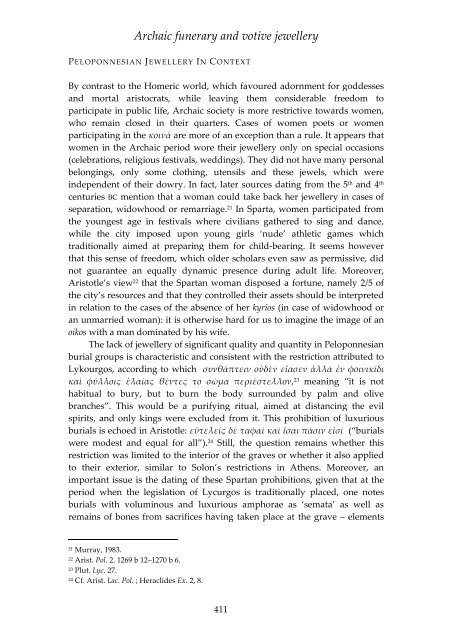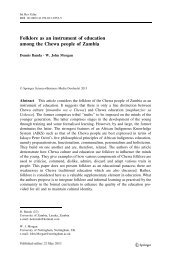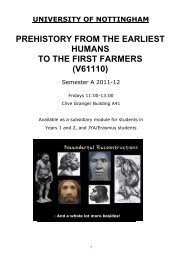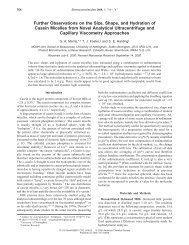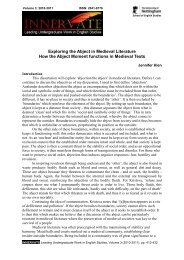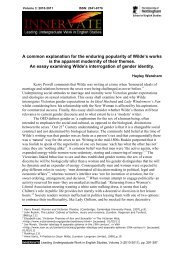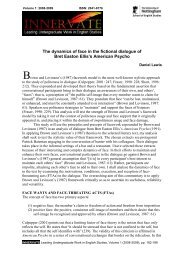Honouring the Dead in the Peloponnese - University of Nottingham
Honouring the Dead in the Peloponnese - University of Nottingham
Honouring the Dead in the Peloponnese - University of Nottingham
Create successful ePaper yourself
Turn your PDF publications into a flip-book with our unique Google optimized e-Paper software.
Archaic funerary and votive jewellery<br />
PELOPONNESIAN JEWELLERY IN CONTEXT<br />
By contrast to <strong>the</strong> Homeric world, which favoured adornment for goddesses<br />
and mortal aristocrats, while leav<strong>in</strong>g <strong>the</strong>m considerable freedom to<br />
participate <strong>in</strong> public life, Archaic society is more restrictive towards women,<br />
who rema<strong>in</strong> closed <strong>in</strong> <strong>the</strong>ir quarters. Cases <strong>of</strong> women poets or women<br />
participat<strong>in</strong>g <strong>in</strong> <strong>the</strong> κοινάά are more <strong>of</strong> an exception than a rule. It appears that<br />
women <strong>in</strong> <strong>the</strong> Archaic period wore <strong>the</strong>ir jewellery only on special occasions<br />
(celebrations, religious festivals, wedd<strong>in</strong>gs). They did not have many personal<br />
belong<strong>in</strong>gs, only some cloth<strong>in</strong>g, utensils and <strong>the</strong>se jewels, which were<br />
<strong>in</strong>dependent <strong>of</strong> <strong>the</strong>ir dowry. In fact, later sources dat<strong>in</strong>g from <strong>the</strong> 5 th and 4 th<br />
centuries BC mention that a woman could take back her jewellery <strong>in</strong> cases <strong>of</strong><br />
separation, widowhood or remarriage. 21 In Sparta, women participated from<br />
<strong>the</strong> youngest age <strong>in</strong> festivals where civilians ga<strong>the</strong>red to s<strong>in</strong>g and dance,<br />
while <strong>the</strong> city imposed upon young girls ‘nude’ athletic games which<br />
traditionally aimed at prepar<strong>in</strong>g <strong>the</strong>m for child-bear<strong>in</strong>g. It seems however<br />
that this sense <strong>of</strong> freedom, which older scholars even saw as permissive, did<br />
not guarantee an equally dynamic presence dur<strong>in</strong>g adult life. Moreover,<br />
Aristotle’s view 22 that <strong>the</strong> Spartan woman disposed a fortune, namely 2/5 <strong>of</strong><br />
<strong>the</strong> city’s resources and that <strong>the</strong>y controlled <strong>the</strong>ir assets should be <strong>in</strong>terpreted<br />
<strong>in</strong> relation to <strong>the</strong> cases <strong>of</strong> <strong>the</strong> absence <strong>of</strong> her kyrios (<strong>in</strong> case <strong>of</strong> widowhood or<br />
an unmarried woman): it is o<strong>the</strong>rwise hard for us to imag<strong>in</strong>e <strong>the</strong> image <strong>of</strong> an<br />
oikos with a man dom<strong>in</strong>ated by his wife.<br />
The lack <strong>of</strong> jewellery <strong>of</strong> significant quality and quantity <strong>in</strong> Peloponnesian<br />
burial groups is characteristic and consistent with <strong>the</strong> restriction attributed to<br />
Lykourgos, accord<strong>in</strong>g to which συνθάάπτειν οὐδὲν εἴασεν ἀλλάά ἐν φοινικίίδι<br />
καὶ φύύλλοις ἐλαίίας θέέντες το σώμα περιέέστελλον, 23 mean<strong>in</strong>g “it is not<br />
habitual to bury, but to burn <strong>the</strong> body surrounded by palm and olive<br />
branches”. This would be a purify<strong>in</strong>g ritual, aimed at distanc<strong>in</strong>g <strong>the</strong> evil<br />
spirits, and only k<strong>in</strong>gs were excluded from it. This prohibition <strong>of</strong> luxurious<br />
burials is echoed <strong>in</strong> Aristotle: εὐτελείίς δὲ ταφαίί καὶ ἴσαι πάάσιν εἰσίί (“burials<br />
were modest and equal for all”). 24 Still, <strong>the</strong> question rema<strong>in</strong>s whe<strong>the</strong>r this<br />
restriction was limited to <strong>the</strong> <strong>in</strong>terior <strong>of</strong> <strong>the</strong> graves or whe<strong>the</strong>r it also applied<br />
to <strong>the</strong>ir exterior, similar to Solon’s restrictions <strong>in</strong> A<strong>the</strong>ns. Moreover, an<br />
important issue is <strong>the</strong> dat<strong>in</strong>g <strong>of</strong> <strong>the</strong>se Spartan prohibitions, given that at <strong>the</strong><br />
period when <strong>the</strong> legislation <strong>of</strong> Lycurgos is traditionally placed, one notes<br />
burials with volum<strong>in</strong>ous and luxurious amphorae as ‘semata’ as well as<br />
rema<strong>in</strong>s <strong>of</strong> bones from sacrifices hav<strong>in</strong>g taken place at <strong>the</strong> grave – elements<br />
21<br />
Murray, 1983.<br />
22<br />
Arist. Pol. 2. 1269 b 12–1270 b 6.<br />
23<br />
Plut. Lyc. 27.<br />
24<br />
Cf. Arist. Lac. Pol. ; Heraclides Ex. 2, 8.<br />
411


